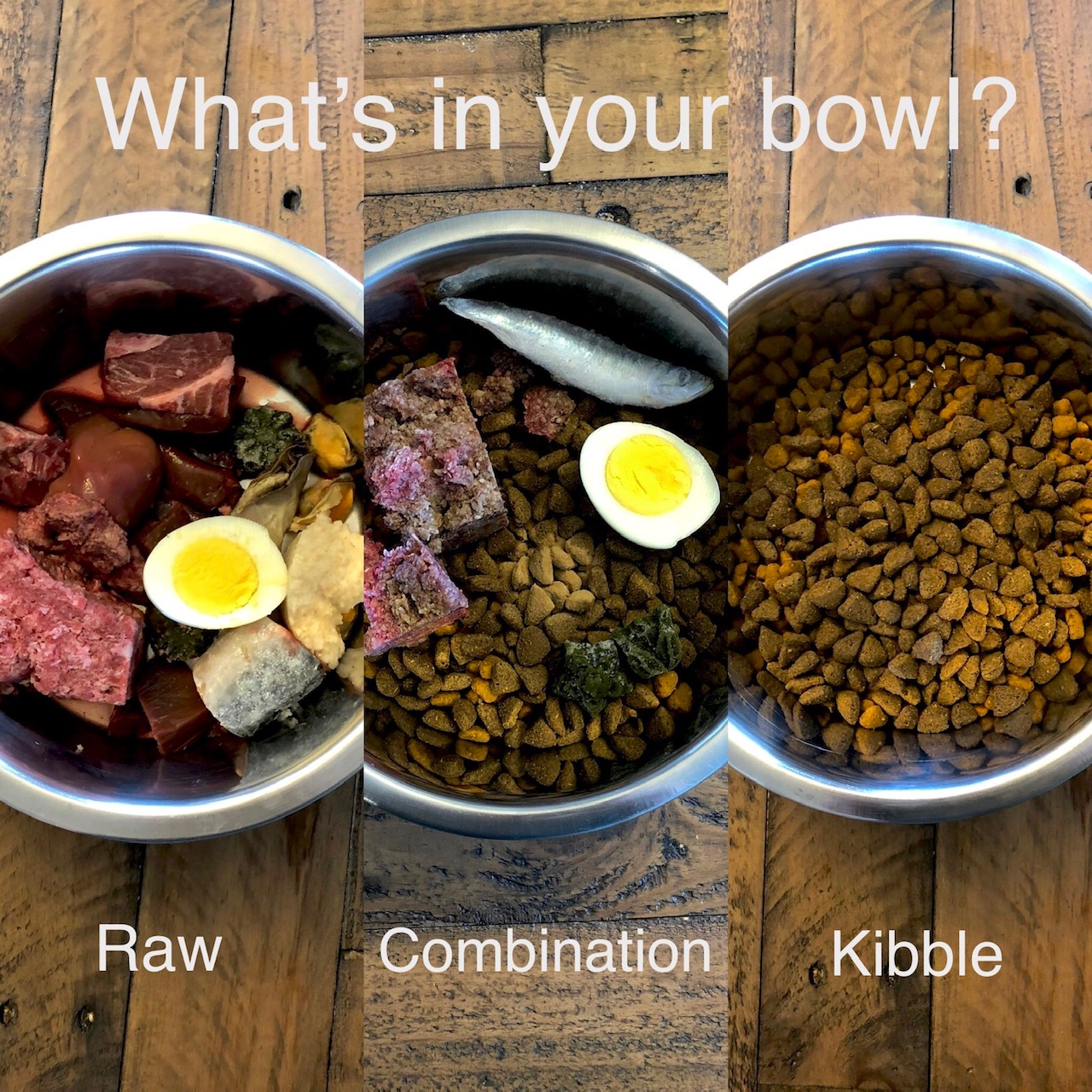Raw or Kibble? GGA does not care! What we care about is that you are feeding a balanced appropriate diet for your dog!
Foreword
In recent months GGA staff have become concerned with the diets that are being fed to retired racing greyhounds. Far too often, we have found that adopters are grossly misinformed and misled about appropriate diets. Please do not choose a diet based on something you have been told by ‘social media’ or advertising, or heard from a friend would be good for xyz. Please please please look into any diet that you are feeding or are thinking about feeding. Diet is not just about putting calories in the body. Your greyhound needs specific essential nutrients in order to thrive. Your vet should be informed of any issues related to diet or of any diet changes. Most vets are not anti(insert diet of choice), they just want to ensure that you have done your research and most importantly that your dog is healthy and getting what it needs.
Introduction
Greyhounds are one of the oldest sighthound breeds, their pedigrees were recorded and registered as early as the 18th century. They are working dogs that were once primarily bred for hunting. Characteristics that were/are an asset for hunting make greyhounds ideal racing athletes. What does that mean exactly? Working dogs have never and should never be thought of in the same way as those little foofoo, two bite, stroller dogs. They should not be subjected to a life of a house pet couch potato (yes, even in retirement). They should be treated like the athletes that they are. Like any other athlete, in order to perform optimally, they need training, physical therapies, leisure time, rest and good nutrition.
Prior to retirement your greyhound ate a diet that consisted of a mixture of kibble, raw ground beef, rice/pasta, vegetables, fruit, eggs, and vitamins. Carb-loading is not just for human athletes! Those big, energy burning, racing muscles require a lot of protein to build and maintain.
Although your retired racing greyhound is no longer the active athlete they once were, they are still the same dog, the same working breed, and should be treated and fed as such. Something to keep in mind is that your greyhound right after retirement and then a year later will likely have vastly different caloric needs. This is due to a change in activity level and muscle tone. A healthy greyhound should be long and lean, with a nice tuck, and the indentation of a rib. They should not be over fed. An overweight dog is an unhealthy dog. Remember, their cardiovascular athletic build isn’t meant to carry an extra 10+lbs. Likewise, an underweight dog is an unhealthy dog. And a diet that isn't balanced to meet your dog's nutritional needs is not worth feeding.
We at GGA do not care what you choose to feed - raw or kibble - so long as it is a good quality, balanced diet. This post is a VERY brief explanation of some of the diets. It is by no means a complete explanation or a 'how to' reference. If you have questions about diet, please speak to your adoption group, your vet and/or someone who is knowledgeable about canine nutrition. This often is not a sales representative, either.
Getting Started
NRC (National Research Council), FEDIAF (European Pet Food Industry Federation), AAFCO (Association of American Feed Control) are organizations that establish guidelines for the minimum nutrient needs of dogs. These guidelines are based on scientific research and the review of scientific studies.
Although NRC, FEDIAF, and AAFCO lay out nutrient guidelines, they are not responsible for how companies choose to meet those guidelines. They just outline what nutrient amounts equal a complete and balanced diet. This means that not all kibbles or premade raw foods are the same or of the same quality. For example, Purina Pro Plan Sport Performance (the kibble GGA feeds) and Ol'Roy are both AAFCO foods but are arguably vastly different in quality.
In order to feed any diet responsibly you must first understand that your dog has specific essential nutrient requirements. Your dog's requirements may differ significantly from your neighbour's dog's requirements - and from your opinions of grain-free, vegetarian or vegan diets. Furthermore, these essential nutrient requirements may not line up exactly with the minimum guidelines stated by NRC, FEDIAF or AAFCO. For example, a working dog will have drastically different nutritional needs than a lapdog. The long-term health of your dog depends on meeting all macronutrient and micronutrient requirements in their diet.
(A very brief word on) Health and Diet
Often we do not link symptoms that we are seeing in our dogs to diet, but we should be. Diet can both improve our dog's health and can cause health issues. Medical conditions, allergies, yeast, parasites, DCM (dilated cardiomyopathy), hair and skin condition are all things to take into consideration when planning the perfect diet for your dog.
Certain medical conditions require certain nutrients to be either increased or decreased in the diet. Just like in humans, allergies can be caused by the environment and by food. Does your dog get a lot of ear infections and have reddish-brown tinged feet that s/he licks a lot? Those can be signs of yeast, and may be solved by a diet change. Does your dog have digestion issues and constant loose stool? It may not be what s/he is eating, check for parasites before making changes to the diet. Look into diet induced dilated cardiomyopathy before selecting a new boutique grain-free kibble brand as some have been linked to an increased DCM risk. Is your dog losing hair and/or have pink-red skin? It could be diet related or it could also be medical.
To sort out any symptoms your dog is exhibiting you need to look at the whole picture and examine both medical and diet causes.
If you do decide to make a change to your dog's diet, whether it is a change in kibble brands, or a change from kibble to raw, or from raw to kibble, or just the addition of some raw ingredients to their kibble diet, it is best to start slowly and only make small changes. Drastic changes to your dog's diet can upset a sensitive digestive systems. Always, let your vet know if you are having issues or making changes.
Raw Diets
Feeding a raw diet properly can be a lot of work, at least in the beginning. Please DO NOT feed a raw diet without doing research and without understanding what your dog requires. It is not ok to just throw your dog a chicken leg and call it a day. It is also not ok to take the word of an employee at your local pet store, even if it is a store dedicated to raw feeding, about what a good premade raw food is. Like kibble, Some premade foods are better than others, some are complete garbage.
Raw diets are high in moisture, low in carbohydrates and have fresh proteins and fats. When feeding a raw diet you may find that your dog drinks less water. Do not just feed chicken and/or beef! It is recommended that you feed a variety of proteins, different proteins help to meet different nutrient requirements. There are a lot of benefits to feeding raw, including: cleaner teeth, fresher breath, better weight control, better digestion, softer/fuller coat, healthier skin, reduced allergies, smaller and less smelly stool, less smelly farts, etc., but it can be a fair amount of work.
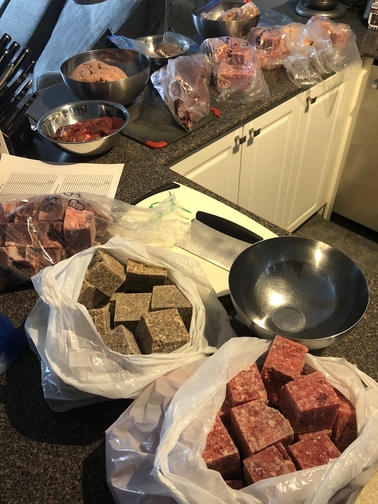
Raw Ratio Diet
If you are new to raw and see the ratio 80/10/10 or 80/10/5/5 in reference to a raw diet, that is a ratio diet. It shows the percentage of meat, edible bones, and secreting organs. For example, an 80/10/10 is made up of 80% raw muscle meat, 10% raw edible bones, and 10% secreting organs (such as 5% liver and 5% other secreting organs). Ratio diets can be a good starting point BUT there are nutritional gaps that need to be addressed. Ratio diets generally do not meet any nutrition standard and are not a good long-term diet.
Some raw feeders will argue that feeding a ratio diet is better than feeding kibble and that feeding a variety of proteins will balance the nutrients overtime. This simply isn't true. Feeding a good quality, balanced kibble is hands down better for your dog than feeding something that fails to take into account nutritional requirements. Furthermore, without an understanding of what nutrients are low or missing, it is not possible to balance overtime.
PMR (Prey Model Raw) Diet
PMR diets are a form of a ratio diet. They do not include plant ingredients and are based on feeding whole, wild prey animals. There are two methods of feeding this type of diet: whole prey and franken prey. Whole prey is exactly what it sounds like, the whole prey animal - head to tail and everything inside including fur or feathers, organs, glands, blood, and intestinal tract, and bones - is fed. A franken prey diet consists of various protein sources in order to meet the nutrient requirements. Based on the whole prey model, the recommended guidelines for franken prey are 75-80% raw muscle meat, 10% raw edible bones, 5% liver, 5% other secreting organs, and 0-5% animal based fiber.
PMR whole prey or ratios alone are not a quality balanced raw diet.
BARF (Biologically Appropriate Raw Foods) Diet
BARF diets are another form of ratio diets, and can be thought of as a “70/10/5/5/7/2/1” ratio, which is only a recommended guideline. The 70/10/5/5/7/2/1 is raw muscle meat, raw edible bones, liver, other secreting organs, vegetables, seeds and nuts, and fruit. Again, you may need to alter the ratios to meet your dog's nutrient requirements.
As with PMR ratios, BARF ratios alone are also not a quality balanced raw diet.
Balanced Raw Diet
As previously stated, ratio diets are a good starting point but if you want to feed raw successfully with your dog's health in mind, you must balance the macro and micro nutrients to meet your dog's specific essential nutrient needs. When balancing a diet for a healthy adult dog it is ok to balance nutrients overtime (time meaning a few days at most) or daily.
There are two ways you can feed a raw diet, DIY or premade.
- DIY: When you DIY a raw diet you can easily select the quantities and types of ingredients to meet your dog's specific essential nutrient needs. It’s easier to avoid ingredients that your dog is allergic to or doesn’t like and it tends to be cheaper. This is GGA staff's chosen method of feeding raw. It is the easiest to formulate and to adjust if needed.
- Premade: Premade raw diets are not all equal, you should not just assume that a premade raw diet meets your dog's nutrient needs, or that it contains the appropriate ratios of ingredients. If you choose to feed a premade raw diet it is important to find out what the ingredients are and what the quantities of those ingredients are. Premade raw diets might still need extra ingredients added in order to fully balance the macro and micro nutrients.
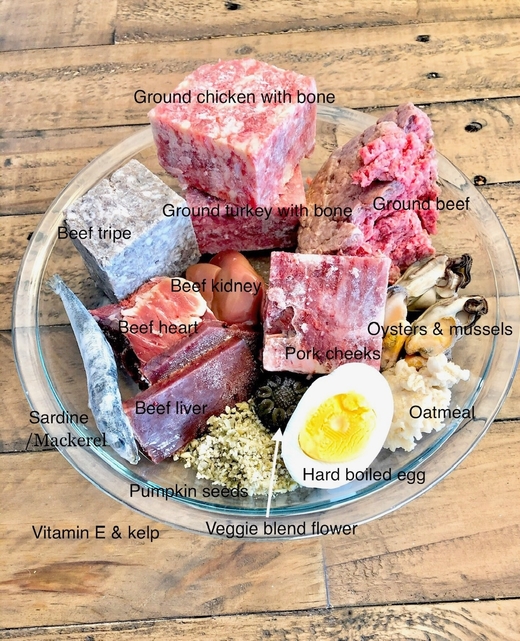
If we were to cover the 'how tos' of raw diet balancing in this post we would only be regurgitating what can already be found in other places. Please see the 'Additional Resources' section below for a more in-depth explanation and for assistance.
There are a lot of tools out there to help you balance your dog's diet, for example:
- https://cronometer.com/
- Raw Fed & Nerdy Formulation Sheet https://rawfedandnerdy.com/formulate (GGA staff uses this one)
You don't have to minor in canine nutrition to formulate a balanced raw diet. Raw Fed and Nerdy offers a relatively short and easy to understand course to help get you started. If you don't have the time or don't want to learn about nutrient balancing you can always pay a qualified canine nutritionist to do it for you. You can find a canine nutritionist that will formulate a balanced raw recipe for you, on the sites listed in the 'Additional Resources' section below.
Plant Ingredients
A common argument is that dogs don't need plant ingredients and can't digest them. This is false. Plant ingredients can provide essential nutrients that help to meet overall carbohydrate, fiber, phytochemical (ex. antioxidant), mineral, fatty acids, and vitamin requirements. Plant ingredients just need to be prepared in the correct ways to optimize digestion and nutrient absorption.
- Raw, unsalted seeds and nuts: Ensure you are not feeding seeds and nuts that are poisonous to dogs. Seeds and nuts must be soaked for at least 24 hours to reduce phytates and then ground to allow for better digestion. Phytates are anti-nutrients that can negatively affect nutrient balances.
-
Vegetables:
- Non-starchy: depending on the vegetable should be steamed and/or pureed, or fermented.
- Starchy: must be boiled or baked until fully cooked.
- Fruit: Due to high sugar content it should be fed in low amounts.
Kibble Diets
Kibble can be high in carbohydrates, low in moisture, and the proteins and fats differ from those found in fresh food. If you choose to feed kibble you should first ensure that it has been formulated to meet nutrient guidelines (ex. NRC, AAFCO, FEDIAF). Second you need to look at what is in the food to determine if those guidelines have been met with quality ingredients.
Just like with premade raw diets, not all kibbles are equal. Companies can choose how they meet those guidelines and not all of them choose quality ingredients. Common ingredients do include “by products” which is similar to the organ meet and edible bones in a raw-type kibble. Do not shy away from these ingredients - your dog needs them. When choosing a kibble for your dog ensure that you are not only choosing a food that meets not only your dog's nutritional needs but also its medical needs. If your dog has a medical condition, loose stool, allergies, dropping weight, etc. consult with your vet about your options. It is not recommended that you change your dog's food just because you think that they are bored of that particular brand. If your worry is economical, again speak to your vet as they can have good insite on quality affordable kibble brands. While you don’t need to spend $100 for a 15 lb bag, you also cannot expect to pay $15 for a 100lb bag of nutritionally complete kibble. There are plenty of good quality reasonably priced kibbles out there.
If you do need to change your dog's diet, it should be gradually changed over at least four days.
- Day 1: 25% new food, 75% old food
- Day 2: 50% new food, 50% old food
- Day 3: 75% new food, 25% old food
- Day 4: 100% new food
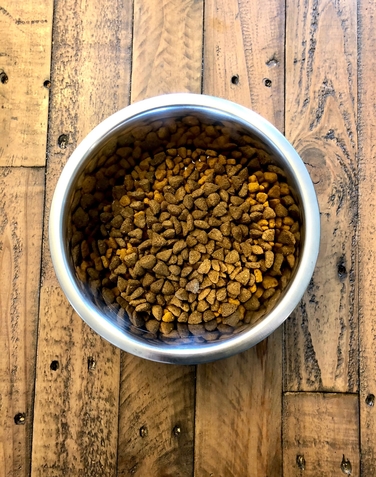
Combination Diets
There is a popular myth that you can't mix kibble with raw. That simply is not true. You can absolutely mix fresh foods into a processed food diet, you just have to do it right. Remember, kibble is formulated using minimum nutrient guidelines. As stated above, those minimum guidelines may not fully meet your dog's specific essential nutrient
needs. Adding in some fresh foods can help to balance out deficits.
However, you should not just randomly add fresh foods to a kibble diet and expect good results. If you are adding more than 20% fresh food to the kibble diet, the fresh food portion must be balanced to ensure macro and micro nutrient needs are met. You cannot rely on the kibble to balance the diet if you are feeding less than 80% kibble. The macro and micro nutrients in the kibble are not designed to balance out other foods. If you are adding less than 20% fresh food, balance is not as important as your dog will be getting its required nutrients from the kibble portion. Please note that this is only for healthy adult dogs.
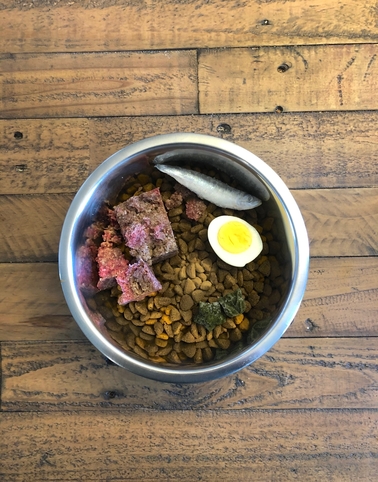
Whether during their racing carriers or as a house pet retired racers do not require the high quality AAA Angus steak that you are BBQing for yourself. Unless you purchase your dog's raw diet at the grocery store, the ingredients being fed in their raw or kibble diet may or may not be of quality for human consumption. And that's okay! The digestive system and needs of our dog differs significantly from our own.
Additional Resources
If you want to learn more and/or need help with your dogs diet, the following links are good place to start:
Facebook groups and websites for balanced PMR and BARF:
Facebook groups and websites that support all balanced diets (don’t be deceived by the name, they support cooked and kibble too):
Raw pet food suppliers in Ontario:
Disclaimer: We at GGA are not experts, or veterinarians, or canine nutritionists. This is not an instructional post on how to feed any particular diet. This post is meant to draw your attention to the importance of researching any diet and ensuring it meets the nutritional needs of your dog. This was written with the healthy adult dog in mind. Please note that puppies have different nutritional needs than adult dogs which in turn have different needs than senior dogs. We have chosen to not cover veterinary prescription diets or cooked diets. Puppies, seniors, pregnant and lactating females and dogs with medical conditions have different needs that need to be considered when formulating a diet.

